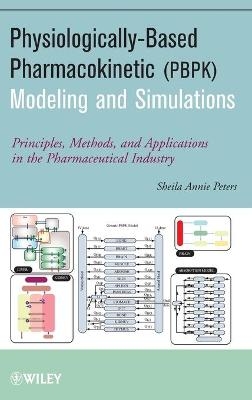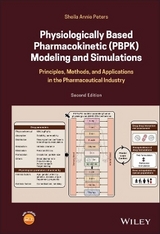
Physiologically-Based Pharmacokinetic (PBPK) Modeling and Simulations
John Wiley & Sons Inc (Verlag)
978-0-470-48406-7 (ISBN)
- Titel ist leider vergriffen;
keine Neuauflage - Artikel merken
Sheila Annie Peters, PhD, is an Associate Principal Scientist for R&I DMPK at AstraZeneca. Previously, she was Principal Scientist at Cyprotex Discovery and lectured at the National Institute of Technology (Trichy, India), University of Madras, and Pondicherry University.
Preface xv Acknowledgments xvii SECTION I. PRINCIPLES AND METHODS 1 1 MODELING IN THE PHARMACEUTICAL INDUSTRY 3 1.1 Introduction 3 1.2 Modeling Approaches 4 1.3 Steps Needed to Maximize Effective Integration of Models into R&D Workflow 7 1.4 Scope of the Book 8 Keywords 10 References 12 2 PHYSIOLOGICALLY-BASED MODELING 13 2.1 Introduction 13 2.2 Examples of Physiological Modeling 14 2.3 Need for Physiological Models in the Pharmaceutical Industry 15 2.4 Organs as Compartments 15 2.5 Bottom-Up vs. Top-Down Modeling in Pharmacokinetics 16 References 16 3 REVIEW OF PHARMACOKINETIC PRINCIPLES 17 3.1 Introduction 18 3.2 Routes of Administration 18 3.3 Drug Disposition 18 3.3.1 Absorption 18 3.3.2 Plasma Protein Binding, BloodPlasma Ratio 20 3.3.3 Distribution, Elimination, Half-Life, and Clearance 23 3.3.4 Role of Transporters in ADME 29 3.4 Linear and Nonlinear Pharmacokinetics 34 3.5 Steady-State Pharmacokinetics 34 3.6 Dose Estimations 37 3.7 Successful PK Optimization in Drug Discovery 40 Keywords 40 References 41 4 PHYSIOLOGICAL MODEL FOR ABSORPTION 43 4.1 Introduction 44 4.2 Drug Absorption and Gut Bioavailability 44 4.2.1 Solubility and Dissolution Rate 44 4.2.2 Permeability: Transcelluar, Paracellular, and Carrier-Mediated Pathways 51 4.2.3 Barriers to Membrane Transport Luminal Degradation, Efflux, and Gut Metabolism 53 4.3 Factors Affecting Drug Absorption and Gut Bioavailability 56 4.3.1 Physiological Factors Affecting Oral Drug Absorption and Species Differences in Physiology 56 4.3.2 Compound-Dependent Factors 62 4.3.3 Formulation-Dependent Factors 63 4.4 In Silico Predictions of Passive Permeability and Solubility 66 4.4.1 In Silico Models for Permeability 66 4.4.2 In Silico Models for Solubility 67 4.5 Measurement of Permeability, Solubility, Luminal Stability, Efflux, and Intestinal Metabolism 67 4.5.1 In Vitro, in Situ and in Vivo Assays for Permeability 67 4.5.2 Measurement of Thermodynamic or Equilibrium Solubility 72 4.5.3 Luminal Stability 74 4.5.4 Efflux 74 4.5.5 In Vitro Models for Estimating Extent of Gut Metabolism 76 4.6 Absorption Modeling 76 Keywords 83 References 84 5 PHYSIOLOGICAL MODEL FOR DISTRIBUTION 89 5.1 Introduction 90 5.2 Factors Affecting Tissue Distribution of Xenobiotics 91 5.2.1 Physiological Factors and Species Differences in Physiology 91 5.2.2 Compound-Dependent Factors 98 5.3 In Silico Models of Tissue Partition Coefficients 98 5.4 Measurement of Parameters Representing Rate and Extent of Tissue Distribution 105 5.4.1 Assessment of Rate and Extent of Brain Penetration 105 5.5 Physiological Model for Drug Distribution 110 5.6 Drug Concentrations at Site of Action 111 Keywords 114 References 115 6 PHYSIOLOGICAL MODELS FOR DRUG METABOLISM AND EXCRETION 119 6.1 Introduction 119 6.2 Factors Affecting Drug Metabolism and Excretion of Xenobiotics 120 6.3 Models for Hepatobiliary Elimination and Renal Excretion 124 6.3.1 In Silico Models 124 6.3.2 In Vitro Models for Hepatic Metabolism 125 6.3.3 In Vitro Models for Transporters 127 6.4 Physiological Models 136 6.4.1 Hepatobiliary Elimination of Parent Drug and Metabolites 136 6.4.2 Renal Excretion 141 References 144 7 GENERIC WHOLE-BODY PHYSIOLOGICALLY-BASED PHARMACOKINETIC MODELING 153 7.1 Introduction 153 7.2 Structure of a Generic Whole Body PBPK Model 154 7.3 Model Assumptions 157 7.4 Commercial PBPK Software 158 References 159 8 VARIABILITY, UNCERTAINTY, AND SENSITIVITY ANALYSIS 161 8.1 Introduction 161 8.2 Need for Uncertainty Analysis 162 8.3 Sources of Physiological, Anatomical, Enzymatic, and Transporter Variability 163 8.4 Modeling Uncertainty and Population Variability with Monte Carlo Simulations 169 8.5 Sensitivity Analysis 172 8.6 Conclusions 174 Keywords 174 References 175 9 EVALUATION OF DRUGDRUG INTERACTION RISK WITH PBPK MODELS 183 9.1 Introduction 184 9.2 Factors Affecting DrugDrug Interactions 186 9.3 In Vitro Methods to Evaluate DrugDrug Interactions 190 9.3.1 Candidate Drug as a Potential Inhibitor 190 9.3.2 Candidate Drug as a Potential Victim of Inhibition 192 9.4 Static Models to Evaluate DrugDrug Interactions 193 9.5 PBPK Models to Evaluate DrugDrug Interactions 195 9.5.1 Intrinsic Clearance of Victim (V) in the Absence of Inhibitor or Inducer 195 9.5.2 Intrinsic Clearance of Victim (V) in the Presence of Inhibitor 196 9.5.3 Time-Dependent Changes in the Abundance of an Enzyme Isoform Inhibited by an MBI 197 9.5.4 Intrinsic Clearance of Victim (V) in the Presence of Inducer 197 9.6 Comparison of PBPK Models and Static Models for the Evaluation of Drug Drug Interactions 198 Keywords 201 References 202 10 PHYSIOLOGICALLY-BASED PHARMACOKINETICS OF BIOTHERAPEUTICS 209 10.1 Introduction 210 10.2 Therapeutic Proteins 210 ftoc 18 January 2012; 14:19:8 10.2.1 Peptides and Proteins 210 10.2.2 Monoclonal Antibodies 212 10.3 Pharmacokinetics of Therapeutic Proteins 214 10.3.1 Peptides and Proteins 215 10.3.2 Monoclonal Antibodies 224 10.4 PBPK/PD Modeling for Therapeutic Proteins 230 10.4.1 Need for PBPK Modeling for Therapeutic Proteins 230 10.4.2 PBPK Modeling for Therapeutic Proteins 231 10.4.3 Pharmacokinetic Scaling 239 10.4.4 Applications of PBPK Models of Therapeutic Proteins 242 10.4.5 PBPK Integration with Pharmacodynamics 244 10.5 Antisense Oligonucletides and RNA Interferance 245 10.5.1 Antisense Oligonucletides (ASOs) 245 10.5.2 Ribonucleic Acid Interference (RNAi) 245 10.5.3 Pharmacokinetics of ASOs50 and Double-Stranded RNAs 247 10.5.4 Design and Modifications of ASOs to Improve Target Affinity and PD: the First, Second, and Third Generation ASOs 249 10.5.5 Integration of PK/PBPK and PD Modeling 253 Keywords 254 References 256 SECTION II. APPLICATIONS IN THE PHARMACEUTICAL INDUSTRY 261 11 DATA INTEGRATION AND SENSITIVITY ANALYSIS 263 11.1 Introduction 263 11.2 Examples of Data Integration with PBPK Modeling 264 11.3 Examples of Sensitivity Analysis with PBPK Modeling 267 References 271 12 HYPOTHESIS GENERATION AND PHARMACOKINETIC PREDICTIONS 273 12.1 Introduction 274 12.2 PBPK Simulations of Pharmacokinetic Profiles for Hypothesis Generation and Testing 274 12.2.1 Methodology 274 12.2.2 In Vivo Solubility 278 12.2.3 Delayed Gastric Emptying 280 12.2.4 Regional Variation in Intestinal Loss: Gut Wall Metabolism, Intestinal Efflux, and Luminal Degradation 282 12.2.5 Enterohepatic Recirculation 284 12.2.6 Inhibition of Drug-Metabolizing Enzymes 286 12.2.7 Inhibition of Hepatic Uptake 286 12.2.8 Inhibition of Hepatobiliary Efflux 290 12.3 Pharmacokinetic Predictions 293 12.3.1 Human Predictions from Preclinical Data 293 12.3.2 Pharmacokinetic Predictions in Clinical Development 293 References 294 13 INTEGRATION OF PBPK AND PHARMACODYNAMICS 299 13.1 Introduction 300 13.2 Pharmacodynamic Principles 300 13.2.1 Pharmacological Targets and Drug Action 300 13.2.2 Functional Adaptation Processes: Tolerance, Sensitization, and Rebound (Fig 13.2) 301 13.3 Pharmacodynamic Modeling 307 13.3.1 ConcentrationEffect, DoseResponse Curves, and Sigmoid Emax Models 307 13.3.2 Mechanism-Based PD Modeling 315 13.3.3 Simple Direct Effects 315 13.3.4 Models Accommodating Delayed Pharmacological Response 321 13.3.5 Models Accommodating Nonlinearity in Pharmacological Response with Respect to Time 332 13.4 Pharmacokinetic Modeling: Compartmental PK and PBPK 335 13.5 Integration of PK or PBPK with PD Modeling 335 13.6 Reasons for Poor PK/PD Correlation 339 13.7 Applications of PK or PBPK/PD Modeling in Drug Discovery and Development 340 13.7.1 Need for a Mechanistic PBPK/PD Integration 341 13.7.2 Applications of PK or PBPK/PD in Drug Discovery 342 13.7.3 Applications of PK or PBPK/PD in Drug Development 360 13.8 Regulatory Perspective 370 13.9 Conclusions 371 Keywords 372 References 376 14 PHYSIOLOGICALLY-BASED PHARMACOKINETIC MODELING OF POPULATIONS 383 14.1 Introduction 383 14.2 Population Modeling with PBPK 384 14.3 Healthy to Target Patient Population: Impact of Disease on Pharmacokinetics 386 14.4 Modeling Subpopulations: Impact of Age, Gender, Co-morbidities, and Genetics on Pharmacokinetics 389 14.5 Personalized Medicine with PBPK/PD 392 Keyword 395 References 396 15 PBPK MODELS ALONG THE DRUG DISCOVERY AND DEVELOPMENT VALUE CHAIN 401 15.1 Summary of Applications of PBPK Models along Value Chain 401 15.2 Obstacles and Future Directions for PBPK Modeling 403 Keyword 405 References 405 Appendices 407 Index 423
| Erscheint lt. Verlag | 27.3.2012 |
|---|---|
| Verlagsort | New York |
| Sprache | englisch |
| Maße | 163 x 241 mm |
| Gewicht | 776 g |
| Themenwelt | Mathematik / Informatik ► Mathematik |
| Naturwissenschaften ► Chemie | |
| ISBN-10 | 0-470-48406-3 / 0470484063 |
| ISBN-13 | 978-0-470-48406-7 / 9780470484067 |
| Zustand | Neuware |
| Informationen gemäß Produktsicherheitsverordnung (GPSR) | |
| Haben Sie eine Frage zum Produkt? |
aus dem Bereich



